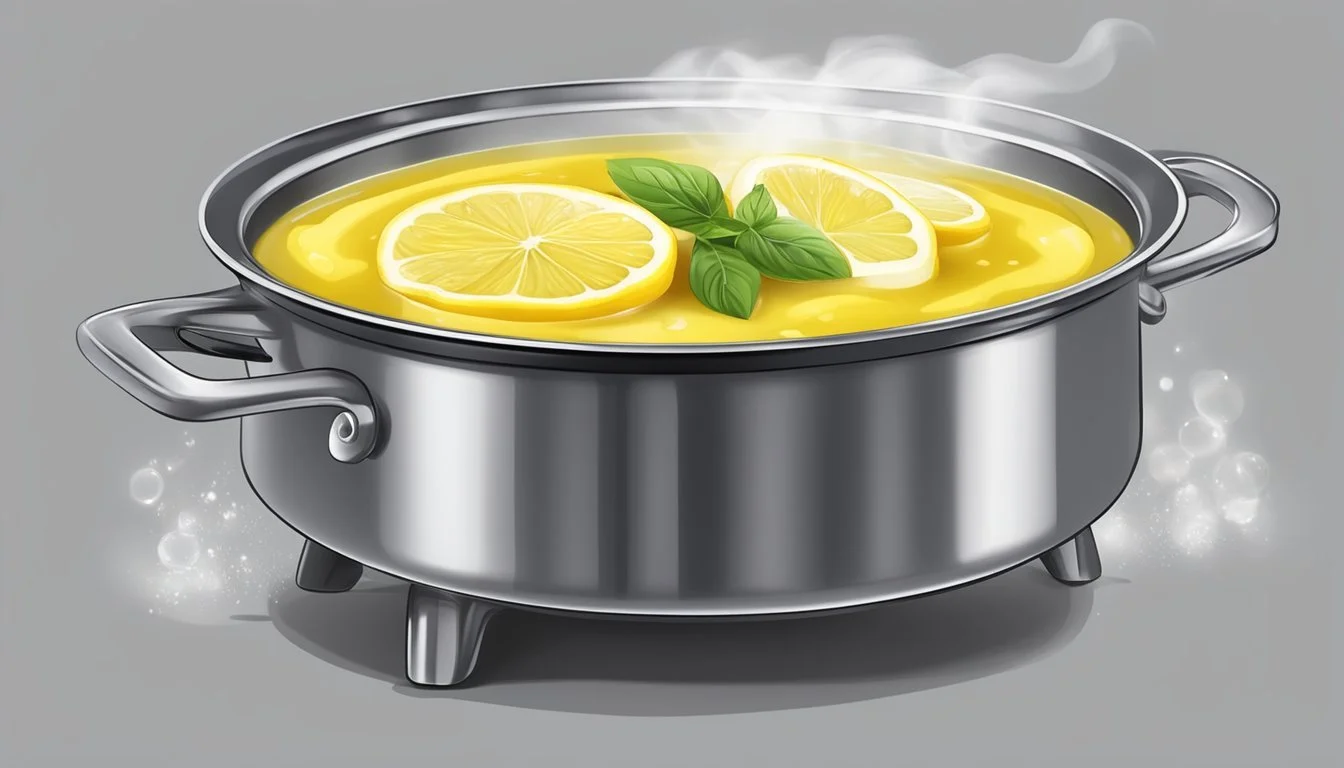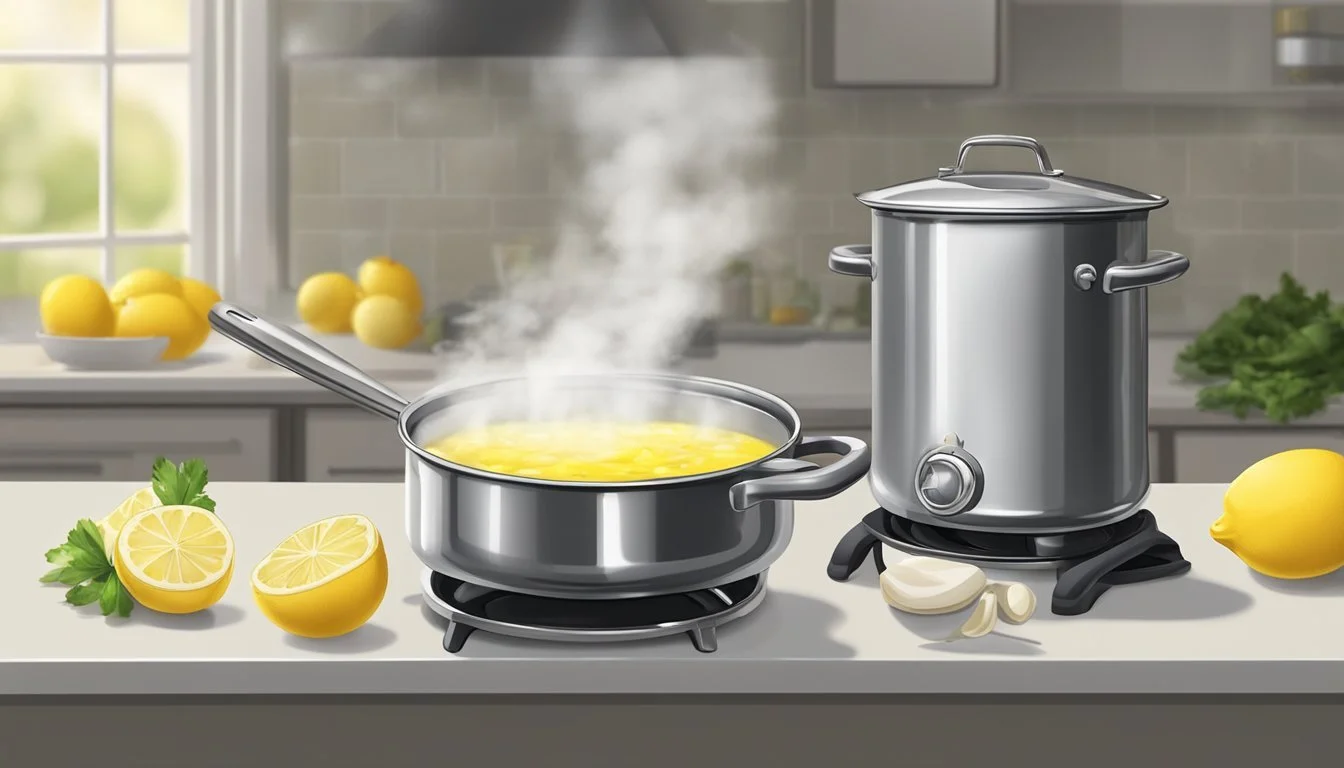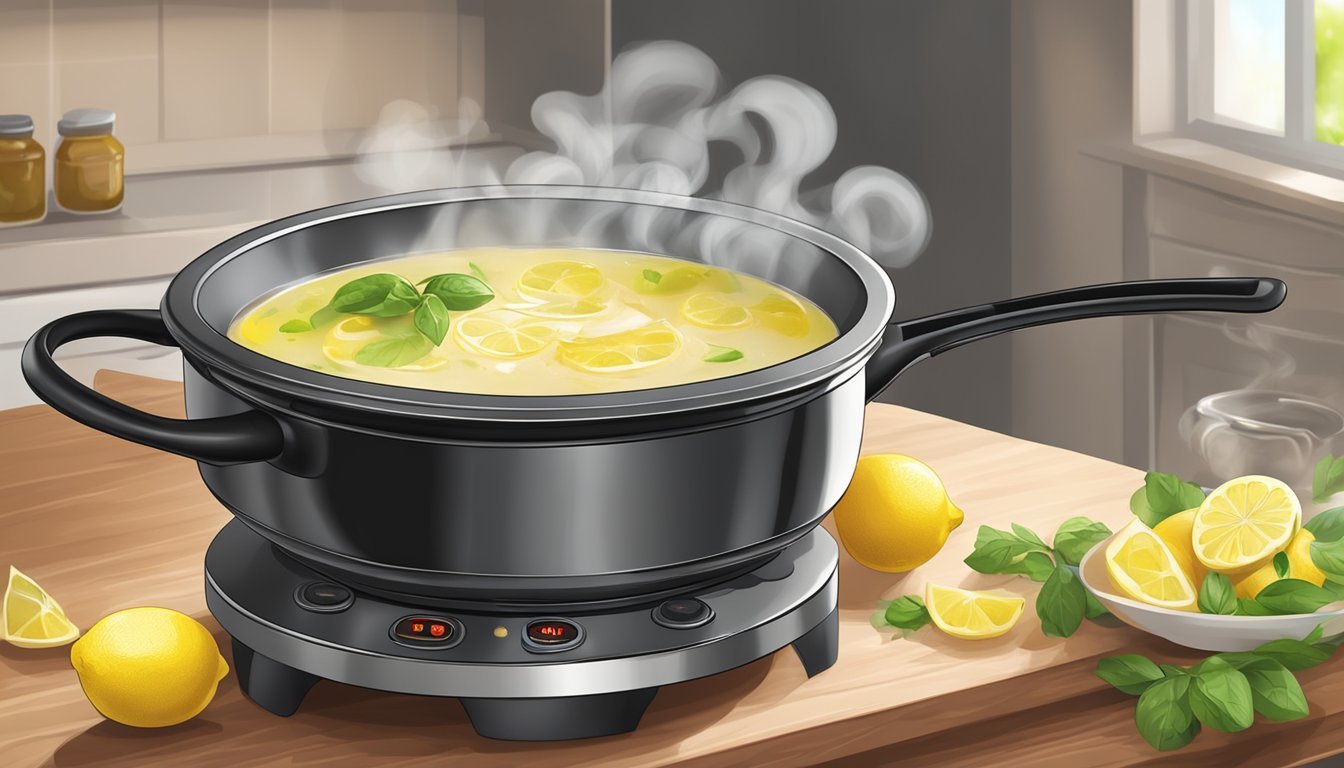Best Way to Reheat Greek Lemon Chicken Soup
Preserving the Zest
Reheating Greek Lemon Chicken Soup, a culinary favorite known for its vibrant tang and comforting warmth, calls for a delicate approach to preserve its distinct flavors. The soup, traditionally known as Avgolemono, combines the zestful taste of lemon, the richness of chicken broth, and the satiating textures of rice and chicken, all brought together with a smooth and creamy liaison of eggs. To maintain the integrity of its tangy flavor profile during reheating, it's crucial to employ techniques that prevent the separation of the emulsified ingredients, such as eggs, which are responsible for the soup's characteristic creaminess.
A common challenge when reheating Greek Lemon Chicken Soup is avoiding the curdling of eggs, which can easily occur when exposed to high heat. The solution lies in gentle and gradual warming, which ensures that the soup retains its velvety quality without sacrificing the bright and zesty lemon essence that is central to the dish. It's equally important to acknowledge the role of the soup's components, as the rice can absorb excess liquid upon standing, necessitating a slight adjustment of broth when reheating to achieve the desired consistency.
Exploring Avgolemono: The Greek Lemon Chicken Soup
Avgolemono is a classic staple of Greek cuisine, celebrated for its comforting qualities and distinctive tangy flavor. This Greek lemon chicken soup merges the zest of lemons with the richness of chicken broth, creating a harmonious blend that is both nourishing and uplifting. The name "avgolemono" reflects its key ingredients: avgo, meaning egg, and lemono, meaning lemon in Greek.
A traditional avgolemono recipe begins with a simple base of chicken broth, infused with vegetables like carrots, celery, and onions to lay the foundation. Seasoned with salt and pepper, and often enhanced with aromatic bay leaves, the introduction of rice or orzo pasta adds a satisfying texture to the soup. As for the chicken, it is either cooked within the broth or added after being prepared separately, ensuring it remains tender and succulent.
The defining feature of avgolemono soup, however, is its signature egg-lemon sauce. This sauce is a mixture of fresh lemon juice and eggs, whisked together until light and frothy. The technique requires care; the mixture must be tempered with warm broth to prevent curdling before being gently stirred back into the pot. This careful process helps maintain the soup's velvety consistency and bright, citrusy essence.
As a Greek dish, avgolemono is more than just a recipe—it's a taste of homemade comfort food that encapsulates the heart of Greek cooking. It is often enjoyed as a warming meal during colder months or as an appetizer to a larger feast, showcasing the versatility and cherished place it holds within Greek culinary traditions.
Essential Ingredients for Authentic Flavor
To ensure the authentic tangy flavor of Greek Lemon Chicken Soup, also known as Avgolemono, it is crucial to select high-quality ingredients. Each component plays a vital role in creating a harmonious and zesty taste profile.
Choosing Quality Chicken
For the soup's protein, opt for fresh chicken breasts or rotisserie chicken as they provide a rich flavor and tender texture. A high-quality rotisserie chicken can also save time and add depth to the soup.
The Zesty Lemon Component
The essence of Avgolemono lies in its lemon flavor. Use fresh lemons for both the juice and zest, ensuring a bright citrus punch. Fresh lemon juice and a hint of lemon zest are recommended for the most vibrant taste.
Herbs and Seasonings
Fresh dill is essential, contributing an aromatic layer to the flavor profile. Staples such as salt, pepper, and bay leaves are also necessary for seasoning. The bay leaves are usually removed before serving, but their subtle presence is felt in every spoonful.
Foundation of Avgolemono: The Broth
A high-quality chicken broth or stock forms the foundation of the soup. Homemade is best, but store-bought can suffice as long as it’s of good quality. Water can be used, but the broth adds more complexity and richness.
Additional Ingredients
For added texture and flavor, incorporate diced carrots, celery, onion, and minced garlic. These vegetables should be sautéed in extra virgin olive oil before adding to the soup for an extra savory note.
Pasta and Rice Alternatives
Traditionally, orzo pasta or white rice is used to add substance to the soup. However, alternatives like couscous (What wine goes well with couscous?), quinoa, or wild rice may be substituted for varied textures or dietary preferences.
Garnishes and Accompaniments
Finish the soup with a sprinkle of chopped fresh dill and fresh herbs such as parsley. Serve with a drizzle of olive oil, crusty bread, or garlic bread, and a side of crumbled feta cheese for additional flavors and textures.
Preparation Techniques
Proper preparation is crucial for reheating Greek Lemon Chicken Soup to maintain its unique tangy flavor and consistency. Attention to the details in cooking the chicken and creating the lemon-egg mixture will ensure the soup retains its character.
Cooking the Chicken
One begins by poaching a whole chicken in a pot of simmering water or broth, infused with aromatic herbs if desired, until the chicken meat is fully cooked and tender. This not only cooks the chicken but also creates a flavorful base for the soup. Here's a simple method:
Place a whole chicken in a large pot.
Fill the pot with enough water or broth to cover the chicken.
Add seasonings such as salt, pepper, bay leaves, or garlic for additional flavor.
Bring to a boil and then reduce to a simmer, cover it.
Cook for about 1 to 1.5 hours or until the internal temperature of the chicken reaches 165°F (74°C).
Remove the chicken, let it cool, and shred the meat into bite-sized pieces.
The chicken should then be set aside, ready to be added to the reheated soup.
Creating the Lemon-Egg Mixture
The lemon-egg mixture, known as "avgolemono", is what gives Greek Lemon Chicken Soup its signature tangy and creamy quality. When mixing these ingredients, they must not cook into scrambled eggs but instead emulsify into the broth. Follow these steps:
Whisk together the juice of 2 lemons and 2 egg yolks in a bowl.
Temper the mixture by slowly adding a couple of ladles of hot broth from the soup, whisking continuously.
Pour the tempered egg-lemon mixture back into the soup pot.
Stir the mixture into the soup over low heat until the soup is creamy and slightly thickened.
By gently incorporating the mixture, the soup achieves the desired texture and zest without curdling the eggs.
The Best Method for Reheating
When reheating Greek lemon chicken soup, the goal is to preserve its tangy flavor and ensure an even temperature throughout. The methods below underscore the importance of gentle reheating to maintain the integrity of the soup.
Stovetop Reheating Steps
Pour soup into a large pot: To begin, transfer the refrigerated Greek lemon chicken soup into a large pot.
Heat gently: Heat the soup over a low to medium flame. This gradual heating process helps to preserve the flavors and prevent the soup from burning or sticking to the bottom of the pot.
Stir occasionally: Stirring occasionally promotes even heating and helps in integrating the flavors throughout the soup.
Monitor temperature: One should keep a close eye on the soup to ensure it does not reach a rolling boil. A gentle simmer is ideal to retain the soup's tangy flavor and creamy consistency.
Microwave Heating Instructions
Transfer to a microwave-safe bowl: Spoon the desired amount of soup into a microwave-safe bowl.
Cover and heat: Cover the bowl with a microwave-safe lid or a damp paper towel to trap in moisture. Heat on medium power in 1-2 minute intervals, stirring in between each interval to promote even distribution of heat.
Utilizing an Instant Pot
Select the 'Sauté' function: Utilizing an Instant Pot offers a controlled reheating environment. Begin by activating the 'Sauté' function.
Reheat in stages: Add the Greek lemon chicken soup to the Instant Pot. Reheat the soup in stages, allowing it to warm up gently to retain its flavors. Stir the soup occasionally.
Adjust heat settings if necessary: If the soup starts to simmer too vigorously, adjust the setting to a lower heat to avoid overcooking and preserving the soup's citrus notes.
Retaining Tanginess and Creaminess
When reheating avgolemono, the Greek lemon chicken soup renowned for its tangy and creamy qualities, one must carefully preserve its distinct flavor profile. The soup's tanginess largely comes from lemon juice, which is rich in vitamin C, while the creaminess is attributed to the emulsification of eggs.
Steps to Reheat While Maintaining Quality:
Gentle Heat: Warm the soup on low heat. High temperatures can cause the eggs to scramble and the soup to lose its creaminess.
Stirring: Constant, gentle stirring is crucial to ensure the soup does not separate and remains comforting and satisfying.
Avoid Boiling: Keep the soup just below a simmer to protect the delicate lemon flavor and prevent curdling.
Acidity Adjustment: If the tanginess has mellowed, a splash of fresh lemon juice can be added after reheating to revive the soup's zesty character.
Nutrient Importance in Avgolemono Vitamin C Preserves tanginess and adds nutrition Eggs Provide creaminess and help to thicken the soup
Tips for Creaminess:
Temper the Eggs: If adding fresh eggs, whisk them separately with a bit of the hot soup before reintroducing them to the pot. This process maintains the soup's smooth texture.
Last-minute Lemon: Fresh lemon juice not only reinforces the tangy aspect but also enhances the overall flavor when added just before serving.
By following these guidelines, one ensures the reheated avgolemono soup remains as delicious and nutritious as when it was first prepared, providing a tangy, creamy, and ultimately satisfying experience.
Avoiding Common Reheating Mistakes
When reheating Greek Lemon Chicken soup, one should consistently apply attentive care to preserve its texture and prevent compromising its delicate flavor profile. The tangy essence of lemon, a cornerstone of this dish's identity, can be easily overpowered or lost with improper reheating techniques.
Heat Gradually: The soup should be heated slowly on a stovetop at a low to medium temperature. This ensures that the flavors meld harmoniously without the soup reaching a rolling boil, which can cause the proteins, especially in the chicken, to toughen and the rice to become mushy.
Stir Occasionally: A gentle stirring procedure helps in keeping the incorporation of ingredients uniform and prevents any ingredients from sticking to the bottom of the pan and possibly burning - an incident which would detract from the soup’s delicious character.
Avoid Direct High Heat: Microwaving the soup on high or quick boiling on the stove can result in an uneven texture and can damage the subtle lemon essence.
Prevent Curdling: If the soup contains eggs, one must take extra caution to reheat it to just below a simmer instead of boiling, as high heat can cause the eggs to curdle and separate.
Use of Fresh Lemon: If the soup's lemon brightness has diminished upon refrigerating, it's advisable to refresh the zest with a light squeeze of fresh lemon juice after reheating, rather than while it is still cold, to rejuvenate its zing without overwhelming the other flavors.
By avoiding these common mistakes, the soup can maintain its delightful flavor and texture, ensuring an enjoyable eating experience upon reheating.
Making the Soup Ahead of Time
Preparing Greek Lemon Chicken Soup in advance can be a time-saver. Proper storage and reheating techniques are crucial to maintain the soup's distinctive tangy flavor.
Storage Guidelines
When storing Greek Lemon Chicken Soup in the refrigerator, one should use an airtight container. The soup will stay fresh for 2-3 days. It's important to allow the soup to cool to room temperature before transferring it to the refrigerator.
Instructions for Freezing
One can freeze Greek Lemon Chicken Soup by following these steps:
Cool the soup: Ensure the soup is at room temperature to prevent ice crystal formation.
Portion the soup: Divide the soup into portions to facilitate easy thawing.
Use freezer-safe containers: Pour the soup into freezer-safe bags or containers. Leave some space at the top as the soup will expand when it freezes.
Label and date: Mark the containers with the content description and date frozen.
Freeze: Place the containers in the freezer. Properly stored, the soup can be frozen for up to 3 months.
Thawing and Reheating Frozen Soup
To thaw and reheat the Greek Lemon Chicken Soup:
Thawing: Transfer the soup from the freezer to the refrigerator and let it thaw overnight. For a quicker method, one can also submerge the container in cold water, changing the water every 30 minutes.
Reheating: Pour the thawed soup into a stock pot and reheat it on the stove over low to medium heat. Stir occasionally to ensure even heating without bringing it to a boil, as it may cause the eggs to curdle and spoil the texture.
Nutritional Benefits
Greek Lemon Chicken Soup is not only a soothing meal but also offers a host of nutritional benefits. The dish is typically high in protein due to the presence of chicken, while the addition of vegetables like carrots, onions, and celery contributes vitamins and minerals.
Protein is essential for muscle repair and growth, and chicken is an excellent source. A single serving can provide a substantial portion of the recommended daily intake. Vitamin C, found abundantly in lemons, is another pivotal nutrient in this soup, known for its immune system support and antioxidant properties.
The soup often includes ingredients like kale or other leafy greens, which are not only nutritious but are also a good source of fiber. Fiber plays a role in digestive health and can help with maintaining a healthy weight.
Nutrient Benefit Protein Muscle repair, growth Vitamin C Immune support, antioxidant Fiber Digestive health, weight management
Maintaining the nutritious quality of Greek Lemon Chicken Soup upon reheating is crucial. To preserve its health benefits, gentle reheating is recommended to avoid breaking down the essential nutrients such as Vitamin C, which can be sensitive to high heat.
This dish, with its blend of protein, vitamins, and fiber, is a nourishing option that contributes positively to a balanced diet. Each ingredient offers its own health advantage, making Greek Lemon Chicken Soup a nutritious choice for a meal.
Serving Suggestions
When serving Greek Lemon Chicken Soup, one should consider the accompaniments and presentation to enhance the dining experience. Thoughtful pairings and aesthetic touches can turn this comforting dish into an impressive meal.
Pairing with Side Dishes
To complement the tangy flavor of the soup, one might opt for a Greek salad adorned with feta cheese and kalamata olives. This not only adds a fresh contrast but also stays true to the soup's Mediterranean roots. Another excellent choice is garlic bread, which provides a satisfying crunch and a rich flavor that pairs well with the soup's zest.
Recommended Side Dishes:
Greek salad with fresh cucumbers, tomatoes, feta cheese, and olives
Garlic bread or toasted pita for dipping
Presentation Tips
The presentation of Greek Lemon Chicken Soup should be as delightful as its flavor. A garnish of fresh dill or parsley not just adds color but also a subtle herby freshness. Elevating the look further, one can include thin lemon slices as a nod to the soup's characteristic ingredient. Such garnishes should be placed thoughtfully, without overwhelming the dish.
Garnish Suggestions:
A sprinkle of finely chopped fresh dill or parsley
A few thin slices of lemon, either floating on top or placed on the soup's rim
Customizing the Recipe
Greek Lemon Chicken Soup is versatile, allowing for a range of substitutions and adjustments to cater to various dietary needs without losing its characteristic tangy flavor. The recipe can be customized to substitute certain ingredients and to adhere to dietary restrictions, ensuring that everyone can enjoy this comforting dish.
Alternative Ingredients and Substitutions
For those looking to explore alternative ingredients, the recipe can be easily adapted. The following table outlines common substitutions:
Original Ingredient Substitution Chicken stock Vegetable broth for a vegetarian option Chicken Tofu or chickpeas for a plant-based protein Orzo Rice or quinoa for a gluten-free alternative Eggs Cornstarch slurry can be used to thicken the soup without eggs
One can also use bone-in chicken to enrich the stock with more flavor and nutrients. If choosing to use bone-in chicken, remember to remove the bones before serving.
Adjusting the Recipe for Dietary Restrictions
Customization extends to those with dietary restrictions, ensuring they can enjoy Greek Lemon Chicken Soup too.
Gluten-Free: To make the soup gluten-free, substitute traditional orzo with a gluten-free pasta or rice. Additionally, confirm that the stock is certified gluten-free.
Low Sodium: Opt for low-sodium stock or use homemade stock to control the salt level. Season with herbs instead of salt to enhance taste.
By incorporating these modifications, Greek Lemon Chicken Soup can be tailored to meet specific dietary needs while maintaining its delightful zest and warmth.
Conclusion
To ensure that the distinctive taste of Avgolemono, the traditional Greek lemon chicken soup, remains intact upon reheating, one must employ careful techniques. The soup's characteristically tangy flavor can be preserved by avoiding high heat and instead gently warming it on the stove over low to medium heat.
Reheating Steps:
Place the leftover soup in a saucepan.
Warm the soup on low heat, stirring occasionally.
If the soup has thickened in the refrigerator, one may add a bit of water or chicken broth to adjust the consistency.
Important Tip: It's crucial to not let the soup come to a boil, as this can cause the eggs to scramble and the soup to separate. Instead, aim for a temperature that restores warmth without altering the soup's creamy texture.
When serving the reheated Avgolemono, one might consider a fresh garnish such as:
A sprinkle of chopped parsley
A pinch of dill
A slice of lemon on the side
The garnish not only adds to the aesthetic but may also enhance the flavor profile. Remember, the key to maintaining the tangy essence of this Greek culinary staple lies in a gentle touch and a bit of patience. With these points in mind, the true essence of Avgolemono can be savored even after refrigeration.








